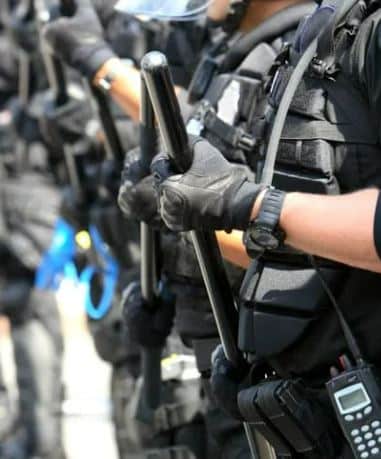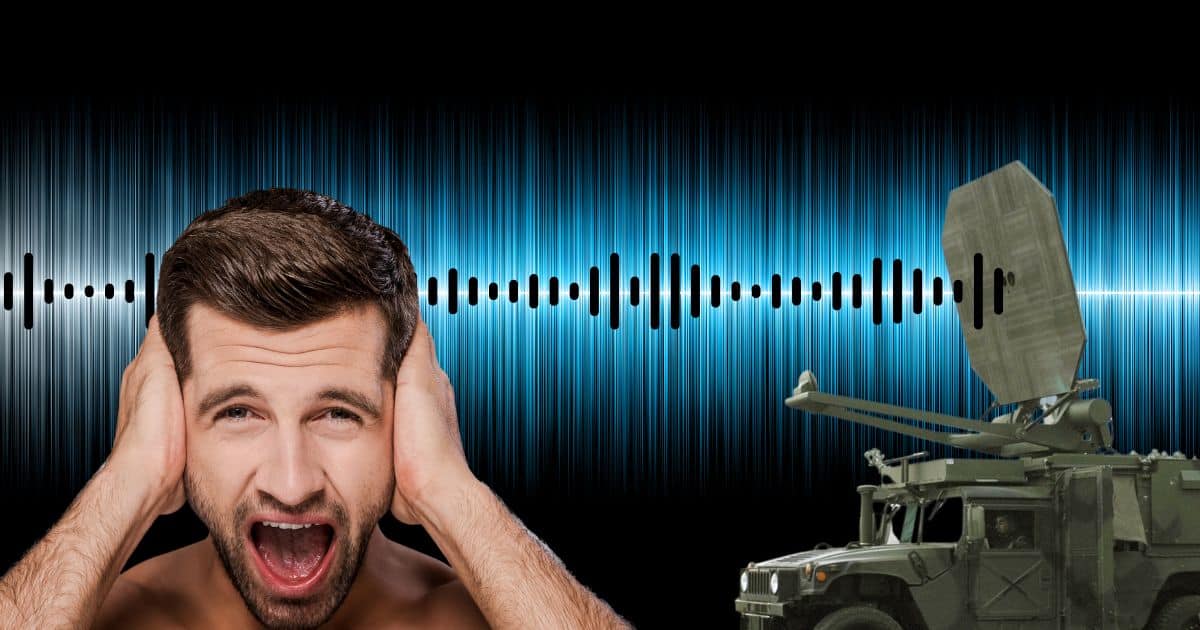Audiologists have long understood the damaging effects of noise on the auditory system. Prolonged exposure to high-level noise above 85-90 dBA can lead to deafness. But what would it take in terms of sound levels to create a truly lethal weapon? The research on this topic is scarce, but it is believed that an extremely loud sound, reaching around 185-200 dB, could potentially cause fatal consequences. Anthony (2014) explains that such a sound could result in an air embolism in the lungs, which could then travel to the heart and prove fatal. Alternatively, the increased air pressure could cause the lungs to burst. While there is limited research on the effects of the most intense sounds, it is difficult to conduct such studies due to ethical reasons and the potential risks involved.
While the use of noise as a weapon may seem like a modern-day tactic against terrorists, it is actually a part of Psychological Warfare (PSY OPS), a strategy that dates back to ancient times, possibly even before Alexander the Great. The contemporary application of PSY OPS utilizing sound can be traced back to World War II. Albert Speer, Hitler’s Chief Architect, conducted research on sonic warfare. His invention, known as the acoustic cannon, involved igniting a mixture of methane and oxygen in a resonant chamber to generate over 1000 explosions per second. These explosions emitted a deafening and focused beam of sound amplified by parabolic reflector dishes.
Although the acoustic weapon developed by Speer was never deployed, it was theorized that by compressing and releasing specific organs in the human body, the cannon could kill an individual standing within 100 yards of the device in just 30 seconds.
Today, certain types of sonic and ultrasonic weapons are employed by military and police forces, while others remain confined to the realm of science fiction. These weapons, often referred to as sonic bullets, grenades, mines, or cannons, emit a concentrated beam of sound or ultrasonic energy to injure, disable, or eliminate an enemy combatant.

Sonic devices, like the LRAD, in recent years have been used in crowd control operations by police, but their use is not without controversy due to the permanent damage they can inflict from the high dB levels produced
Goodman (2009) delves into the concept of sonic warfare, exploring the use of acoustic forces and their impact on different populations. It investigates how sound can be utilized to induce discomfort, convey threats, or instill an atmosphere of fear and dread, essentially creating a negative psychological environment. Goodman highlights examples such as the “psychoacoustic correction” employed by the U.S. Army against Manuel Noriega in Panama and the Branch Davidians in Waco, sonic booms or “sound bombs” deployed over the Gaza Strip, and high-frequency rat repellents employed to deter teenagers in malls. These weapons are even utilized against pirates attempting to hijack cruise ships.
In conclusion, the lethal potential of sonic weapons remains a subject with limited research and numerous ethical considerations. However, throughout history, sound has been employed as a tool of psychological warfare, designed to unsettle, intimidate, and harm. The exploration of acoustic forces and their impact on individuals and populations continues to be an area of interest and concern, as the development and deployment of such weapons persist in military and law enforcement contexts.
How Does a Sonic Weapon Work?
Sonic warfare, with its various techniques and effects, has been employed in different situations with notable outcomes. Manuel Noriega, who sought refuge in the Vatican embassy in Panama City, experienced the relentless barrage of rock music by Guns N’ Roses, while the Branch Davidians endured sleep deprivation through continuous broadcasts of jet planes, pop music, chants, and the distressing sounds of rabbits being slaughtered. While sonic warfare encompasses diverse methods and outcomes, infrasound possesses unique characteristics that make it an especially effective weapon.
Infrasound is characterized by its low frequency and long wavelength, which allow it to bend around or penetrate the human body, generating an oscillating pressure system. Due to its ability to resonate with different parts of the body, infrasound can have unusual non-auditory effects. For instance, at 19 Hz and safe sound levels (<100 dB), exposure to a 19-Hz sound can cause eye twitching when sitting in front of a powerful subwoofer or listening to modulated audible sound. When the volume is increased towards 110 dB, individuals may even perceive colored lights at the periphery of their vision or ghostly gray regions in the center. This is because 19 Hz is the resonant frequency of the human eyeball, and the low-frequency pulsations distort its shape and exert pressure on the retina, activating the rods and cones through mechanical stimulation rather than light.
Studies have revealed that various parts of the body will vibrate at specific frequencies with sufficient power. Human eyeballs, filled with fluid, lungs with gas, and the abdomen housing a mixture of liquid, solid, and gas compartments, all have limits to their stretching capacity when subjected to force. When powerful vibrations are directed at these structures, they stretch and contract in sync with the low-frequency vibrations of the surrounding air molecules.
The challenge with infrasonic frequencies lies in our limited ability to perceive them audibly, which often leads to underestimating their intensity. At around 130 dB, the inner ear experiences direct pressure distortions that are unrelated to normal hearing, potentially affecting speech comprehension. Nausea and whole-body vibrations, particularly in the chest and abdomen, become noticeable at approximately 150 dB. As the intensity reaches 166 dB, breathing difficulties arise as the low-frequency pulses impact the lungs. At around 177 dB, infrasound ranging from 0.5 to 8 Hz can induce an abnormal rhythm, capable of driving sonically induced artificial respiration.
Understanding the potential of infrasound as a weapon sheds light on its significant impact on the human body. While our perception of infrasound is limited, its ability to resonate and manipulate specific bodily structures poses a serious threat. The study and exploration of sonic warfare, including the use of infrasound, continue to provoke discussions on ethical considerations and the need for comprehensive research.
Long Range Acoustic Device (LRAD)
An LRAD (Long Range Acoustic Device) is a powerful sonic weapon and communication device that emits focused, high-intensity sound waves over long distances. It is designed to be used in various scenarios, including crowd control, maritime security, and military operations. LRADs have been deployed by law enforcement agencies, military forces, and private security firms around the world.
The LRAD works by producing a highly directional beam of sound using advanced acoustic technology. The device typically consists of a large parabolic dish or an array of smaller speakers that focus and amplify the sound waves. By precisely controlling the direction and intensity of the emitted sound, an LRAD can target specific areas or individuals.
The primary purpose of an LRAD is to emit a loud and piercing noise, often described as a high-pitched tone or a series of rapidly pulsating sounds. This sound can be extremely discomforting and even painful to the human ear, causing disorientation, dizziness, and a strong urge to move away from the source. The intensity of the sound can reach up to 162 decibels, which is well above the threshold of pain and can potentially cause permanent hearing damage if exposed for extended periods at close range.
LRADs are designed to be highly directional, allowing operators to focus the sound towards specific targets while minimizing the sound dispersion to surrounding areas. This enables law enforcement or military personnel to communicate commands or warnings over long distances, even in noisy environments or during chaotic situations.
While the LRAD is primarily used for its deterrent and communication capabilities, its intense sound output has also raised concerns about potential misuse and human rights violations. There have been debates surrounding the LRAD’s effects on health, including hearing damage and the possibility of other physiological effects. The use of LRADs in various contexts continues to be a subject of scrutiny and regulation to ensure their appropriate and responsible deployment.
References:
Antony, S. (2014). Can a loud enough sound kill you?. Extreme Tech. Retrieved March 4, 2015: https://www.extremetech.com/extreme/175996-can-a-loud-enough-sound-kill-you
Goodman, S., (2009). Sonic Warfare. MIT Press. Retrieved March 4, 2014: https://mitpress.mit.edu/books/sonic-warfare
Zadeh, J. (2014). A history of using sound as a weapon. Retrieved March 4, 2015: https://motherboard.vice.com/read/a-history-of-using-sound-as-a-weapon
Horowitz, S. (2012). Could a sonic weapon make your head explode? Popular Science. Retrieved March 4, 2015: https://www.popsci.com/technology/article/2012-11/acoustic-weapons-book-excerpt
IMAKID (2014). The imagekid has it. Retrieved March 4, 2015: https://imgkid.com/noise-level-chart.shtml
Video:
Disclose TV (2013). Sonic weapons bullets made of sound. Retrieved March 5, 2015: https://www.youtube.com/watch?v=W8h4tV1fpDw
About the author

Robert M. Traynor, Ed.D., is a hearing industry consultant, trainer, professor, conference speaker, practice manager and author. He has decades of experience teaching courses and training clinicians within the field of audiology with specific emphasis in hearing and tinnitus rehabilitation. He serves as Adjunct Faculty in Audiology at the University of Florida, University of Northern Colorado, University of Colorado and The University of Arkansas for Medical Sciences.
**this piece has been updated for clarity. It originally published on March 4, 2015







18 Hz is where the brain resonates inside the skull, which can induce TBI.
Great article pointing out the dark side of amplification technologies.
Thanks for the insights.
Dan…….